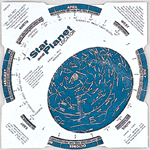

Summary
The student learns to use a planisphere -- the projection of the celestial
sphere on a plane. She will learn to locate constellations,
stars, and planets at any time of year.
Background and Theory
The rotation of the Earth on its axis causes the stars to rise and set each
evening. In addition, the orbit of the Earth around the Sun places different
regions of the sky in our night-time view. A chart of the night sky will map
the locations of the stars; a planisphere will let us know which stars will be
visible during any time of night for any time of year.
Procedure
Position the planisphere so that the side with the title (not the instructions)
is facing you. Notice on the planisphere that the names of the
constellations are given in all capital letters and that the names of the
stars are given in smaller letters. Note, too, that the brighter the star is,
the larger the representative circle. Find the magnitude scale that
accompanies the planisphere (this may be included in a supplementary
brochure). Note that the brighter the star the smaller the magnitude number.
Exercises
Answer the following questions:
- Define "horizon".
- The oval hole on the planisphere represents the visible sky. What part
of this oval represents the Earth's horizon?
Note the outside of the star wheel with the months and days indicated.
Set the wheel to the month, day, and time of your birth. That is, line up
the time of day with the day and month. (On some planispheres it is
necessary to extrapolate to daylight hours if they are not marked.)
- Define "zenith". Use the planisphere to find a star or
constellation that was near the zenith when you were born.
- Define "meridian". Name three stars or constellations that were on the
meridian when you were born.
As you look at the planisphere, does it seem as if West and East are
reversed? The planisphere represents a map of the sky. Hold the
planisphere as you would if you were really outdoors observing.
- Pretend you are facing North. How would you hold the planisphere?
- Turn until you are facing West. What adjustment must you make
with the planisphere so that you can accurately read the map?
How about when you turn to face South or East?
Find the North, East, South, and West horizons on the planisphere.
- What star was rising in the eastern sky at the time you were born?
- What star was setting on or near the western horizon at the time you were
born? What constellation was on or near the northern horizon?
Turn the planisphere counter-clockwise 360 degrees to represent the
passing of 24 hours. Note the date passes through all of the times on the
star wheel.
- The central rivet "punches" through what star?
- Why is this star used as the center?
- If you were at the North Pole, where would you find this star?
- If you were at the equator, where would you find this star?
- This star is part of which constellation?
- Name three constellations that are always above the horizon (never rise
or set) from the northern, mid-latitudes.
- Name two constellations that are visible at 10 pm tonight but not
at 2 am tomorrow morning. (Thought question: What horizon
should you be looking at on the planisphere?)
Find the circles representing the ecliptic (dashed line) and celestial
equator (solid line).
- Name four constellations on the ecliptic.
- What does the ecliptic represent?
- Name four constellations that lie on the celestial equator.
- What is the celestial equator?
- Find the region representing the Milky Way, our home galaxy. Name
three constellations visible tonight that lie along the plane of the Milky
Way.
As you know, even though astrology formed the roots of astronomy,
astrology has absolutely no scientific basis. As astronomers, we no
longer concern ourselves with horoscopes.
- Astronomically the zodiac is significant. Why?
Your sign of the zodiac supposedly
represents the constellation the Sun was in on the day you were born.
Check out this table that lists the astrological
versus the astronomical signs of the zodiac (Watch astrology sink
even further away from any scientific basis.)
- Astrologically, what is your sign of the zodiac?
- Astronomically, what is your sign of the zodiac?
- Why would there be a difference between an astrological and an
astronomical sign of the zodiac?
- What is your favorite constellation.
On the first clear night of the quarter, go outside with your planisphere
and find your favorite (or any other) constellation. What difficulties did
you have when actually trying to use this planisphere?
(a rhetorical question)
© 2003 Weber State University
Revised: 24 April, 2003
